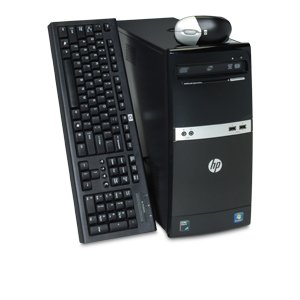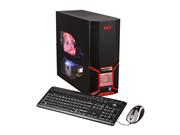Back To School Technology Buyer's Guide
by Zach Throckmorton on August 4, 2011 8:55 PM ESTRetail desktops
Component for component, retail desktops rarely offer as much value or flexibility as a comparable DIY desktop, especially if as a student you have access to heavily discounted OS licenses. However, retail desktops are often a good choice if the primary user is not especially tech-savvy. Retail desktops come with technical support and straightforward warranties. That is, they're potentially less of a headache in case something goes awry. When shopping for retail desktops, it is very important to shop around for remarkable sales. That said, we outline below what you can typically expect at four different price points.
Less than $300

At $300, retail desktops typically feature previous-generation CPUs, less than 4GB of memory, smaller hard drives, and integrated (i.e. non-gaming) graphics. That said, these very inexpensive PCs are still up to basic productivity tasks like web browsing and document creation, as well as sound and video playback. The Acer Veriton VX275-UD5800W is an example of such a computer. Its dual-core Intel Pentium E5800 processor is based on a CPU architecture that is now two generations old, it has 2GB of RAM, and a 320GB hard drive. It's an attractive choice for college students because it's tiny—16" deep by 4" wide by 11" tall. Its 4" width is a small desk footprint; it could easily be placed on a typical dorm room desk while leaving plenty of room for other items. Considering the very low cost of RAM, upgrading it to a more comfortable 4GB would cost less than $15.
Around $400

At $400, give or take, retail desktops start having good enough hardware that you can get four years of basic usage from them. Budget current-generation processors, 4GB RAM, smaller hard drives, and integrated graphics are typical in this price range. HP's 505B has specifications similar to the AMD micro-ATX system outlined on the previous page. The most important difference is the HP's PSU is 300W, and like most retail computer PSUs, it's likely not even capable of supplying that much electricity. The weak PSU severely limits this system's expandability in terms of adding more hard drives or a GPU. Also, the HP case is not nearly as attractive as the Fractal Core 1000! That said, it's a solid value at just over $400.
Around $500

As a long-time computer enthusiast, it truly amazes me how much power can be purchased for $500 today. At $500, lower mid-range CPUs, more than adequate 6GB or 8GB of memory, and large hard drives abound, though these systems usually lack discrete GPUs (if you're not gaming, this does not matter). The Gateway DX4850-45u is exactly $500, has a quad core Intel Core i5 CPU, 6GB DDR3, and a 1TB hard drive. This system is respectably powerful today, and it will be very serviceable in four years. Its chassis also includes a few niceties like easily-accessible media card readers and more than typical USB ports. Its optical drive not only reads and writes CDs and DVDs, it can also read Blu-ray discs. WiFi is integrated. Unfortunately it also includes an anemic 300W PSU, so upgrading it with anything more powerful than a low-end gaming GPU will require upgrading the power supply as well.
Around $700

At $700, retail PCs typically contain higher mid-range processors, 8GB RAM, large hard drives, and begin to include decent gaming GPUs. You usually get better bang for the buck at this point if you get away from the Dell and HP systems, where there's a major premium for decent graphics cards, and that's what we've selected here. CyberpowerPC's Gamer Xtreme 1314 houses the very capable Intel Core i5-2500K CPU, 8GB memory, a 1TB hard drive, and an AMD Radeon HD 6670 GPU. AnandTech reviewed the 6670 a few months ago and found it to be capable of producing acceptable frame rates (i.e. 30FPS or higher) in most games at resolutions less than 1080p and medium settings. The 6670 is not an enthusiast gamer's card, but it's okay for casual gamers, or hardcore gamers who like older titles (think World of Warcraft). Unfortunately, its motherboard will not facilitate overclocking the Core i5-2500K. Note that as the cost of the retail PC has risen on this page, so has its performance discrepency with the comparable DIY system. The Intel Core i5-2500K-based PC on the previous page has an enthusiast gamer-grade GPU, an SSD, a more feature-rich and overclockable motherboard, an aftermarket CPU heatsink for better overclocking results, and a much higher quality power supply for less than $100 more than this retail PC.
Now that we've covered both build your own and pre-built systems, the next page looks at what you'll actually be looking at: monitors.










94 Comments
View All Comments
Freakie - Saturday, August 27, 2011 - link
Kind of surprised to see you guys leave out higher end ASUS computers and Clevo barebones. ASUS has the best warranties out there, hands down, and their prices for the whole package are amazing when you factor that in.And then you have bang vs buck. You get much more when you go with a Sager and buy Windows with your student discount (Win 7 Pro direct from Microsoft, not the school, for $30). And the repair-ability of Clevo barebones makes any problems after your warranty a LOT cheaper and they are built to be user-serviceable. ASUS laptops also have a noticeably higher amount of user-serviceability than most other OEMs. Buying from a OEM in general when it comes to laptops is just a bad idea, from Apple to Voodoo, your overall experience is gonna suck a majority of the time when compared to ODMs.
harth234 - Friday, August 9, 2013 - link
Could we get another one of these for 2013?ternerdaniel - Monday, August 30, 2021 - link
Regardless of the specialty in which the student studies, a small high-performance laptop with parameters that meet the tasks with which he works will be very useful. With such a gadget, you can quickly make informative notes right during a lecture, work on various projects and presentations, use the literature you need during your studies without wasting time visiting libraries, prepare any test papers, essays, and abstracts in printed form. Also for studies, you will need an interesting educational resource https://bestessayservicesradar.com/best-essay-writ... which contains useful materials for studies. And in some fields of study, such as IT, law, and economics, computers are simply essential in the learning process.kath1mack - Wednesday, April 13, 2022 - link
Oh, yeah! We are very lucky now that have all these technologies. My teachers always require a bibliography section which takes a lot of time to make.